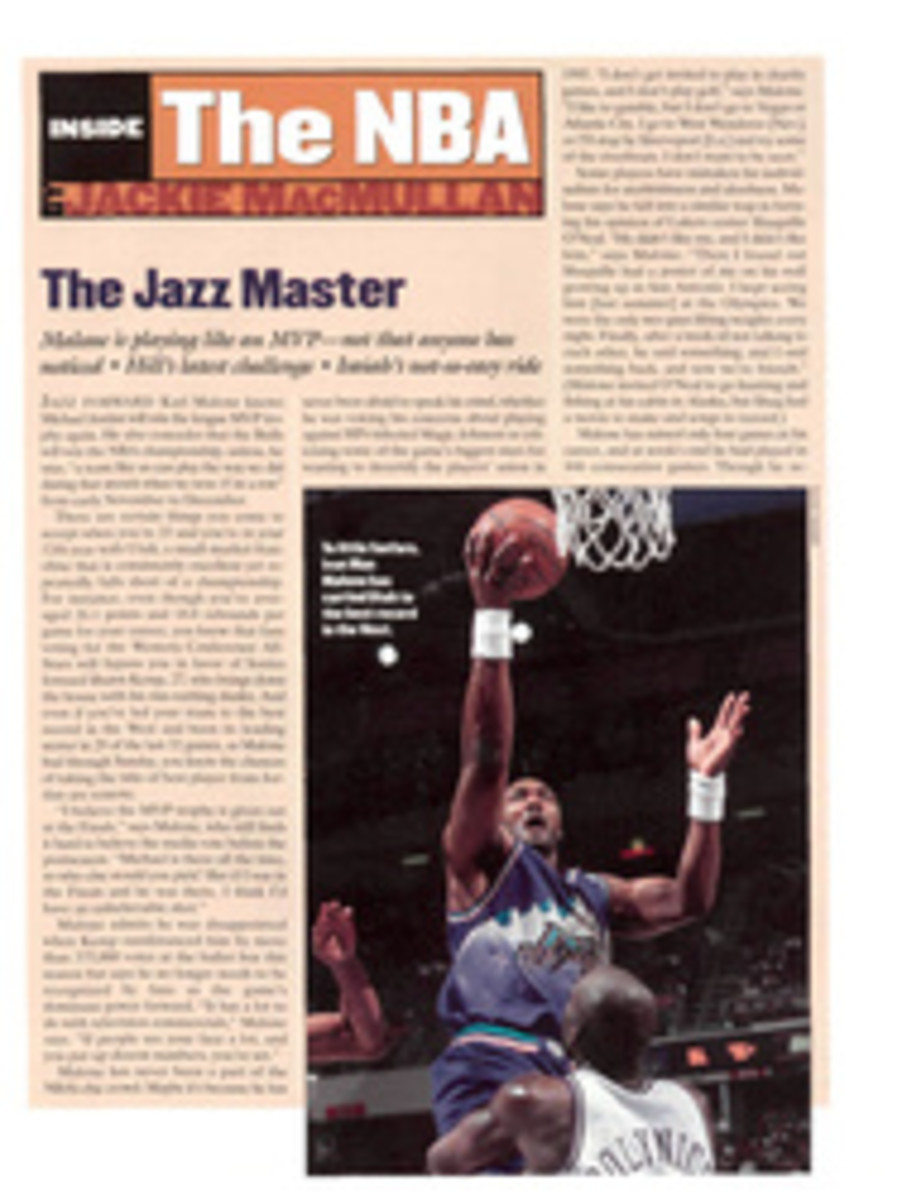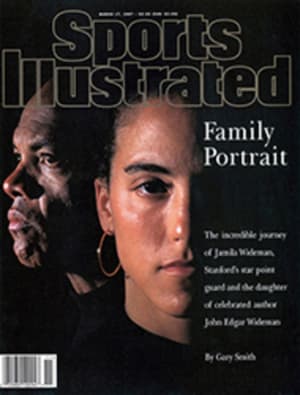
RACE AGAINST TIME NEOPHYTE LINDA RUNYON, A WALL STREET STAR, FACES LONG ODDS IN HER OLYMPIC QUEST
At 8:15 a.m. Merrill Lynch's daily Morning Call is in progress.
Ten thousand stockbrokers and traders at the firm's New York
City headquarters and in offices around the world are on the
phone listening to industry updates from the company's team of
research analysts. Yesterday the Federal Communications
Commission finished auctioning off billions of dollars in
mobile-phone licenses, and the sales force is interested in the
recommendations of Merrill Lynch's top wireless-communications
expert, 32-year-old Linda Runyon.
Seven hundred miles from Wall Street, in a ground-floor
apartment on Milwaukee's east side, Runyon, dressed in red
sweatpants, a faded black turtleneck and white wool socks, is
preparing her notes. A computer screen flashes yesterday's stock
prices as snow falls steadily in the dark outside. Spread in
front of Runyon are financial statements, company reports and a
small black stopwatch. Morning Call is running a little late
today, and Runyon is hoping to finish her remarks in three
minutes.
When it's her turn to start talking, Runyon presses the
stopwatch and cheerfully begins, "Hello, everybody!" Her
presentation is detailed, smooth and confident, but, at 3:36, a
little more than her target. It is her first time trial of the
day.
That stopwatch has kept Runyon's life on schedule since the day
in 1994 when she asked Merrill Lynch to let her move to
Milwaukee so she could pursue her long-odds dream of making the
U.S. Olympic speed skating team. Although she was an avid racer
on in-line skates and had played collegiate ice hockey, she had
only one weekend of experience on speed skates. And she was 30
years old--young for one of Wall Street's top research analysts
but old to be vying for an Olympic berth in an endeavor in which
most of the elite competitors had been participating since
childhood.
"Some people felt I was a little crazy," says Runyon, who a
decade ago was a three-sport athlete--field hockey, ice hockey
and lacrosse--as well as a Phi Beta Kappa classics major at
Harvard. "But it seemed like an incredible challenge, and I
thought it was definitely worth trying." Fortunately for Runyon,
so did Merrill Lynch.
"If anyone could make this arrangement work," says her boss,
global equity research director Andrew Melnick, "Linda could."
Three years later it seems to be working just fine. The move to
the Midwest hasn't hurt Runyon's performance at Merrill Lynch:
She has maintained her position as Institutional Investor
magazine's first-team wireless-telecommunications analyst. More
remarkably, the Brookline, Mass., native has moved from a
standing start to the upper echelon of U.S. women's speed
skating. She finished sixth in the 5,000 meters and 10th in the
3,000 at last December's U.S. Allround Championships, making
herself a candidate for the Olympic team at the 1998 Games in
Nagano, Japan. Runyon forwards her two phone lines to voice mail
just as the stock markets are starting to heat up in New York.
At 9:30 she sets out for the Milwaukee Heart Institute, where
Dr. Carl Foster and his stationary bike are waiting.
Foster, the U.S. International Speedskating Association's chair
of sports medicine, admits he was skeptical when he heard about
"this New Yorker who has come to town to be a speed skater." He
changed his mind after he put Runyon through a battery of tests
on the wind-load simulator bike, which tests a cyclist's
capacity to withstand wind resistance. "Linda's got some motor,"
says Foster, who has been working with her regularly since last
August to help her increase cardiovascular output. "If she had
decided to buy a rowing machine instead of in-line skates, she
might be going for the Summer Olympics in rowing."
The in-line skates had been an early 30th-birthday present to
herself in July 1994, and it wasn't long before Runyon was
competing in road races. Two months later, following the lead of
several other in-line racers who had begun experimenting on ice,
Runyon traveled to Pettit National Ice Center in West Allis,
Wis., one weekend to give it a try. "I was lousy, very slow,"
she recalls. "But I loved the ice." Three months later she moved
out of her Greenwich Village apartment and headed for Milwaukee.
From the start Foster was impressed with Runyon's mental drive.
"If you want to understand Linda's success, just look at those
eyes." He cups his hands like goggles. "She has something
different in there. It's a funny look that says, I'll jump over
any hurdle and keep jumping."
Well into Runyon's fourth of seven one-kilometer intervals on
the bike at a 41-kph pace, those eyes are near tears. Runyon's
face is beet red, and she is moaning. Sweat drips down her
muscular 5'6", 142-pound frame. "I've only met two people with
the same kind of focus: [Olympic gold medalists] Bonnie Blair
and Dianne Holum," says Foster.
Heady company for a neophyte, but Runyon will need every bit of
encouragement. To have a chance in the Olympic trials come
December, she needs to improve her time in the 3,000 by at least
17 seconds and in the 5,000 by 22 seconds. Her current personal
best at 3,000 is 4:41.4, compared with Kirstin Holum's U.S. best
of 4:18.33; at 5,000 Runyon is 41 seconds behind Kirstin's U.S.
best of 7:18.59. But it's worth noting that in the last nine
months Runyon has improved her times in the 3,000 (by 18
seconds) and the 5,000 (by 36 seconds) by more than her coach,
former Olympian Jeff Klaiber, feels she needs to improve this
year to make the team.
After completing the final interval, Runyon looks at her
stopwatch with a grimace. "I died on the last one." She is
bothered by a sore left knee that has prevented her from running
all year. (On Jan. 27 Runyon would undergo arthroscopic surgery
to clean out the underside of her kneecap. The operation would
keep her off the ice for four weeks.)
Runyon quickly heads home, where she finds 18 phone messages, 13
E-mail messages and 30 pages of faxes. Before replying to
anything, she enters her times on a spreadsheet programmed with
time targets for the rest of the year.
For the next five hours she wears her analyst's hat, taking
calls from communications-company executives, checking in with
Merrill Lynch's institutional clients and completing
arrangements with her New York-based secretary and research
associate for a business trip to Philadelphia and Washington the
next day.
Just past 4 p.m. Runyon turns off her computer and heads for the
cavernous Pettit Center, a 15-minute drive. The snowstorm has
kept Klaiber from getting to the rink. Stopwatch in hand, Runyon
immediately begins the first of six three-lap intervals on the
gleaming ice.
After each interval she pauses to record her splits and talk
with more experienced skaters around the track. One ad hoc
adviser this evening is Leah Poulos Mueller, an Olympic silver
medalist in 1976 and 1980 who met Runyon when Linda arrived in
Milwaukee. "Initially, some people around here thought that
skating would just be a passing thing for her, that she had just
too far to go, that she was too old to start," says Mueller as
Runyon whizzes by. "But Linda's still here, and she's doing well."
Runyon's getting to Nagano depends on whether she can keep
improving her skating technique. According to Klaiber, with whom
she meets four days a week, Runyon swings her upper torso too
much and relies too little on the power of her hips. The best
speed skaters, Klaiber says, "do less to get more." If Runyon is
to perfect her technique before the trials, he continues, it is
crucial that she come to practice mentally alert. "When you're
involved in multimillion-dollar deals all day," he says,
"there's a risk of getting emotionally washed out by the time
you reach the rink." He recommended that, to help clear her head
for practice, she not make calls from the car on the way to the
Pettit Center. Runyon credits Klaiber, who juggles coaching with
an advertising-agency job in Chicago, for her rapid improvement.
Runyon's high-powered job is a double-edged sword. It limits her
to 20 hours a week of practice--barely half that of her fellow
competitors--but it also gives her full financial support, which
is rare in this amateur sport. In fact, the paucity of funding
for speed skaters has guaranteed a lack of depth in the U.S.
ranks, which partly explains how a novice such as Runyon could
break into the top ranks so quickly.
After two hours on the ice Runyon stops at a nearby gym to do
some weight work on her abdominal muscles. Then she heads home,
where she records her times, returns calls to West Coast clients
until 10 p.m. and grabs a few hours of sleep before an early
flight to Philadelphia.
"Obviously I'll be disappointed if I don't make the [Olympic]
team," says Runyon. "But I know I've worked very hard to give
myself a fighting chance. And from where I started, that's all I
realistically could have asked."
John Solomon was one year ahead of and three sports behind Linda
Runyon at Harvard.
COLOR PHOTO: PHOTOGRAPHS BY JOHN BIEVER With Klaiber (in hat) urging her on, Runyon has reduced her times in big chunks. [Linda Runyon and Jeff Klaiber speed skating]
COLOR PHOTO: PHOTOGRAPHS BY JOHN BIEVER Working at home in Milwaukee, Runyon has 10,000 listeners for Merrill Lynch's Morning Call. [Linda Runyon talking on telephone]

